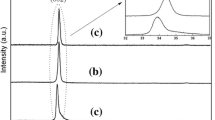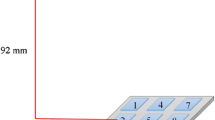Abstract
The system of atomic-layer Al-doped ZnO (AZO) superlattice is rather interesting in that it exhibits a “bipolar transparency,” as it is transparent in the visible and opaque in the infrared to microwave. Here, we report on our measurements of the infrared and microwave shielding properties of thin films (~150 nm) of an Al-doped ZnO superlattice grown via atomic layer deposition (ALD). These optically transparent conductive oxide thin films have large DC electrical conductivity (>50,000 S/m) which increases with Al doping. Their infrared optical properties are well described by a free-electron (Drude) model, which results from the very large carrier concentrations (>3 × 1020 cm−3) resulting from AlO x -heterolayer-doping. It is found that increasing Al concentrations lead to an increase in the relaxation energy which, however, is not strong enough to cause the plasma frequency to red-shift. Microwave shielding properties were investigated in the frequency range from 1 to 30 GHz, and shielding efficiencies as high as ~22 dB were observed, confirming that the free-electron picture extends into the microwave regime. The dynamic conductivity in the microwave range was found to correspond well to the measured DC values. Due to their high electrical conductivity and high microwave shielding efficiency in thin film format, these materials may be desirable for applications in transparent electronics, optically transparent EMI shielding coatings, and heat/microwave reflecting coatings for windows.







Similar content being viewed by others
References
Hosono H, Paine DC, Ginley DS (2010) Handbook of transparent conductors, vol 1. Springer, Berlin
Hamberg I, Granqvist CG (1986) J Appl Phys 60(11):R123
Lee DJ, Kim HM, Kwon JY, Choi H, Kim SH, Kim KB (2011) Adv Funct Mater 21(3):448. doi:10.1002/adfm.201001342
Lee DJ, Kwon JY, Kim SH, Kim HM, Kim KB (2011) J Electrochem Soc 158(5):D277. doi:10.1149/1.3568881
Smits FM (1958) Bell Syst Tech J 34:711
Kitano H, Ohashi T, Maeda A (2008) Rev Sci Instrum 79(7):074701. doi:10.1063/1.2954957
Booth JC, Wu DH, Anlage SM (1994) Rev Sci Instrum 65(6):2082
Martens HCF, Reedijk JA, Brom HB (2000) Rev Sci Instrum 71(2):473
Xu H, Anlage SM, Hu LB, Gruner G (2007) Appl Phys Lett 90(18):183119. doi:10.1063/1.2734897
Dressel M, Grüner G (2002) Electrodynamics of solids: optical properties of electrons in matter. Cambridge University Press, Cambridge
Stuchly MA, Stuchly SS (1980) IEEE Trans Instrum Meas 29(3):176
Kilbride BE, Coleman JN, Fraysse J, Fournet P, Cadek M, Drury A, Hutzler S, Roth S, Blau WJ (2002) J Appl Phys 92(7):4024. doi:10.1063/1.1506397
Dutta P, Biswas S, Ghosh M, De SK, Chatterjee S (2001) Synth Met 122(2):455
Mott NF, Davis EA (1979) Electronic processes in non-crystalline materials. International series of monographs on physics, 2nd edn. Oxford University Press, Oxford
Hawthorne EI (1954) Proc IRE 42(3):548
Lasitter HA (1964) IEEE Trans Electromagn Compat Emc6(2):17
Asbalter J, Karunakaran S, Subrahmanyam A (1999) Proceedings of international conference on electromagnetic interference and compatibility, vol 366
Huang JL, Yau BS, Chen CY, Lo WT, Lii DF (2001) Ceram Int 27(3):363
Sarto F, Sarto MS, Laciprete MC, Sibila C (2003) Rev Adv Mater Sci 5(1):329
Kim WM, Ku DY, Lee IK, Seo YW, Cheong BK, Lee TS, Kim IH, Lee KS (2005) Thin Solid Films 473(2):315. doi:10.1016/j.tsf.2004.08.083
Greco S, Sarto MS, Tamburrano A (2008) International symposium on electromagnetic compatibility—EMC Europe, 8–12 September 2008, pp 1–6. doi:10.1109/emceurope.2008.4786870
Yamada T, Morizane T, Arimitsu T, Miyake A, Makino H, Yamamoto N, Yamamoto T (2008) Thin Solid Films 517(3):1027. doi:10.1016/j.tsf.2008.06.047
Rubinger CPL, da Cunha AF, Vinagre F, Ribeiro GM, Costa LC (2009) J Appl Phys 105(7):074502. doi:10.1063/1.3093690
Kittel C (2005) Introduction to solid state physics, 8th edn. Wiley, Hoboken
Born M, Wolf E (1999) Principles of optics: electromagnetic theory of propagation interference and diffraction of light 7th expanded edn. Cambridge University Press, Cambridge
Jagadish C, Pearton SJ (2006) Zinc oxide bulk, thin films and nanostructures: processing, properties and applications. Elsevier, Amsterdam
Rhodes CL, Lappi S, Fischer D, Sambasivan S, Genzer J, Franzen S (2008) Langmuir 24(2):433. doi:10.1021/La701741m
Qiao ZH, Agashe C, Mergel D (2006) Thin Solid Films 496(2):520. doi:10.1016/j.tsf.2005.08.282
Ali HM, Abd El-Raheem MM, Megahed NM, Mohamed HA (2006) J Phys Chem Solids 67(8):1823. doi:10.1016/j.jpcs.2006.04.005
Volintiru I, Creatore M, van de Sanden MCM (2008) J Appl Phys 103(3):033704. doi:10.1063/1.2837109
Wolfram S (1996) The mathematica book, 3rd edn. Cambridge University Press, Cambridge
Acknowledgements
This research was made possible by funding from AFOSR, AOARD, and the WCU Hybrid Materials Program of Seoul National University.
Author information
Authors and Affiliations
Corresponding author
Rights and permissions
About this article
Cite this article
Fernandes, G.E., Lee, DJ., Kim, J.H. et al. Infrared and microwave shielding of transparent Al-doped ZnO superlattice grown via atomic layer deposition. J Mater Sci 48, 2536–2542 (2013). https://doi.org/10.1007/s10853-012-7043-5
Received:
Accepted:
Published:
Issue Date:
DOI: https://doi.org/10.1007/s10853-012-7043-5




